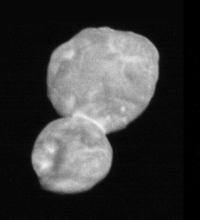Listen to today's episode of StarDate on the web the same day it airs in high-quality streaming audio without any extra ads or announcements. Choose a $8 one-month pass, or listen every day for a year for just $30.
You are here
Keeping it Going
For New Horizons, the big moment of glory came in 2015, when it flew past Pluto. Yet its work isn’t done. The spacecraft is traveling through the Kuiper Belt — a zone of icy bodies beyond the orbit of Neptune, the Sun’s most remote major planet. It flew close to one of those bodies in 2019. Now, it’s scanning other members of the belt from long range. It’s also studying the outer regions of the Sun’s magnetic “bubble,” and looking into deep space.
New Horizons is expected to keep going into the next decade. So scientists are taking advantage of its position, more than five billion miles away. It’s near the edge of the Sun’s region of magnetic influence. It’s only the fifth spacecraft to journey that far. It’s headed in a different direction from the others, so it’s giving scientists a 3-D look at that zone.
The view of deep space from the Kuiper Belt is especially dark, so New Horizons’ instruments have a good view of it. They’ve discovered that the space between galaxies is brighter than expected. A recent study suggests that glow could be produced by particles of dark matter interacting with each other.
Astronomers are looking for new members of the Kuiper Belt for New Horizons to study. That’s resulted in the discovery of hundreds of objects. If things work out, they might even find one that New Horizons could fly close to — one last moment of glory for a hard-working spacecraft.
Script by Damond Benningfield






